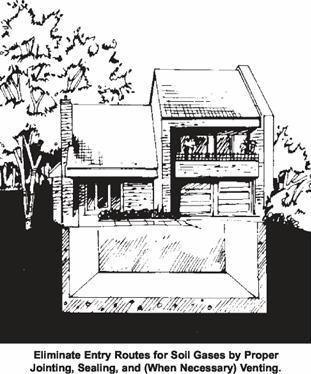

CIP #18 - Radon Resistant Buildings
WHAT is Radon?
Radon is a colorless, odorless, radioactive gas which occurs naturally in soils in amounts dependent upon the geology of the location. The rate of movement of radon through the soil is dependent primarily upon soil permeability, degree of saturation, and differences in air pressure within the soil. Soil gas enters buildings through cracks or openings in the foundation, slab, or basement walls when the air pressure in the building is less than that of the soil.
Radon gas decays to other radioactive elements in the uranium series. Called “radon progeny,” they exist as solid particles rather than as a gas.
WHY be Concerned about Radon Levels in Buildings?
The concern is due to an association with the development of lung cancer. Radon progeny can become attached to dust particles in the air. If inhaled, they can lodge in the lung. Energy emitted during radioactive decay while in the lung can cause tissue damage, which has been linked to lung cancer.
The level of health risk associated with radon is related to the concentration of radon in the air and the time a person is exposed to that air. The U.S. Environmental Protection Agency (EPA) has developed a risk profile for radon exposure at various concentrations, and established an action level concentration above which efforts should be made to reduce radon levels. It is prudent to take measures during construction which will reduce the amount of radon entering a building.
HOW to Construct Radon-Resistant Concrete Buildings?
Solid concrete is an excellent material for use in constructing radon resistant buildings. It is an effective barrier to soil gas penetration if cracks and openings are sealed. Solid concrete slabs and basement walls are commonly used in residential buildings. Buildings resistant to radon may be easily constructed with concrete. In concrete construction, the critical factor is to eliminate all entry routes through which gases can flow from the soil into the building.
The construction of radon-resistant buildings requires adhering to accepted construction practices with attention to a few additional details. In instances where high radon levels are expected, installation of a sub-slab ventilation system incorporating an open-graded aggregate base beneath the slab may be warranted during construction. These systems provide a positive means of evacuating soil gas from beneath the slab, diverting it directly to the outside.
Follow These Guidelines to Reduce Radon Entry:

1. Design to minimize utility openings. Sump openings should be sealed and vented outdoors.
2. Minimize random cracking by using control and isolation joints in walls and floors. Planned joints can then be easily sealed. If done properly, any
cracks will occur at the joints and can be easily sealed.
3. Monolithic slab foundations are an effective way to minimize radon entry. For slab on grade homes in warm climates, pour foundation and slab as a
single monolithic unit.
4. Use materials which will minimize concrete shrinkage and cracking (larger aggregate sizes and proper water-cementitious ratio).
5. When using polyethylene film beneath the slab, place a layer of sand over the polyethylene (See CIP 5 and CIP 7).
6. Remove grade stakes after striking off the slab (if left, they can provide entryways through the slab).
7. Construct the joints to facilitate caulking.
8. Cure the concrete adequately (See CIP 11).
9. Caulk and seal all joints and openings in the walls or floor (if cracks occur, they should be widened, and then caulked and sealed).
References
1. “A Citizen’s Guide to Radon—What It Is and What To Do About It,” U.S. Environmental Protection Agency, OPA-86-004, 1986, 13 pp. Available from state radiation protection offices or EPA regional offices.
2. “Radon Reduction in New Construction—An Interim Guide,” U.S. Environmental Protection Agency, OPA-87-009,1987, 7 pp. Available from EPA, (513) 569-7771.
3. “Radon Reduction Techniques for Detached Houses— Technical Guide,” U.S. Environmental Protection Agency, EPA/625/5-86/019,19N, 50 pp. Available from EPA Center for Environmental Research
Information, (513) 569-7562.
4.
“Production of Radon-Resistant Slab on Grade Foundations,” Florida Institute
of Phosphate Research, Bartown, Florida, 1987, 9 pp.
5. “Guide to Residential Cast-In-Place Concrete Construction,” ACI 332R, American Concrete Institute, Farmington Hills, MI.
6. “Production of Radon-Resistant Foundations,” A. G. Scott and W. O. Findlay, American ATCON, Inc., Wilmington, Delaware, 1987, 54 pp. Available from NTIS, Alexandria, Virginia, PB 89-116149/WBT,
(703) 487-4650.
7. Technical information on radon-resistant construction is available from the National Association of Home Builders, National Research Center, Radon Research Program, (301) 249-4000.
1982, 1989, 2000
![]()